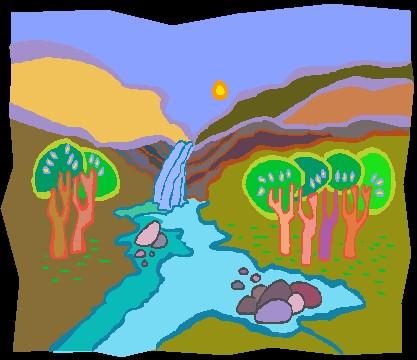Watersheds

What is a watershed?
Every body of water has a watershed. A watershed is an area of land that drains all of its water to a specific lake or river. As rainwater and melting snow run downhill, they carry sediment and other materials into our streams, lakes, wetlands and groundwater.
The boundary of a watershed is defined by the watershed divide, which is the ridge of highest elevation surrounding a given stream or network of streams. A drop of rainwater falling outside of this boundary will enter a different watershed and will flow to a different body of water.
Why Are They Important?
We all live in a watershed. Everyone relies on water and other natural resources to exist. What you and others do on the land impacts the quality and quantity of water and our other natural resources.
Healthy watersheds are vital for a healthy environment and economy. Our watersheds provide water for drinking, irrigation and industry. Many people also enjoy lakes and streams for their beauty and for boating, fishing and swimming. Wildlife also need healthy watersheds for food and shelter.
Managing the water and other natural resources is an effective and efficient way to sustain the local economy and environmental health.
Scientists and leaders now recognize the best way to protect the vital natural resources is to understand and manage them on a watershed basis. Everything that is done in a watershed affects the watershed's system.
Most of the public drinking water in Wake County comes from Falls Lake Reservoir or Lake Wheeler, and the remaining drinking water supply to private well users is supplied by groundwater. Pollution in streams and lakes may keep us from using them for recreation.
What is Watershed Management?
Watershed management is a term used to describe the process of implementing land-use practices and water management practices to protect and improve the quality of the water and other natural resources within a watershed by managing the use of those land and water resources in a comprehensive manner.
Wake County is developing comprehensive watershed management plans for each of the county's 12 watersheds. A watershed management plan serves as a tool to identify and address the issues affecting our environment and to protect and restore the county's streams and other water resources.
By focusing on activities in the entire area that drains to a water body, watershed management programs take a holistic approach to protecting streams, rivers, lakes and wetlands. As such, watershed management programs often require inter-jurisdictional cooperation, as well as cooperation among government agencies and among governments, businesses, developers and citizens.
Watershed management programs include land use planning, regulation of development, control of water pollution, stream buffer protection and stream restoration, and outreach and education. Watershed management considers all sources of pollution in a watershed, including spills and leaks, factories, and stormwater runoff from urban and agricultural areas. In an urban area stormwater is the main source of pollution to local streams.
Help Your Watershed
Environmental stewardship is everyone’s responsibility. By making small changes to your lifestyle, you can help protect and improve the quality of your watershed.
-
Absorb or use rainwater on-site: Create a rain garden, install a rain barrel or help absorb more water by reducing the lawn area and add more plants and trees.
-
Fertilize in the fall, if at all: Excess fertilizers are washed off the land into streams by stormwater, polluting county streams and lakes.
-
Clean up after pets: Pet waste should be put in the trash or flushed down the toilet. Waste left on the ground washes into streams and contributes to high levels of bacteria in our water.
-
Properly dispose of household chemicals: Storm Drains are not the place to dump household waste. The Wake County Division of Solid Waste Management accepts and disposes of household hazardous chemicals from Wake County residents free of charge.
-
Join a stream cleanup: Trash is not only unsightly; it is a hazard to the animals that make streams their homes. There are several regional cleanups throughout the area every year.
-
Participate in watershed planning: Learn in which watershed you live and find the status of planning efforts in your watershed.
Links
